Section 2 : Southern Door ~ Learning with Open Heart and Mind
Chapter 2: What is Canada? ~ What is Turtle Island? ~ Who are the Mi’kmaq Peoples? ~ What are Teachings?
In the Beginning
Let us begin by discussing ‘in the beginning‘. The two readings relating to the Creation Story is the best place to start. The first reading is the Haudenosaunee Creation Story, which is told by Keller George, Wolf Clan member of the Oneida Indian Nation’s Council. While there are several versions of the Sky Woman Creation Story including Basil Johnstone’s version covered in the second reading, I chose George’s recounting as I also have a story about the Oneida Indian Nation No. 41, also known as Oneida Nation of the Thames. This nation is one of several original nations of the Haudenosaunee Confederacy which includes the Mohawk, Oneida, Onondaga, Cayuga and Seneca peoples. My story, like that of Keller George’s story, highlights the dual existence of good and evil spirits.
I have a story about this territory; but, let’s return to the readings about the origin or creation of humans.
- What did you think?
- What knowledge did you obtain?
- Do you have a similar story of creation in your culture?
- Lastly, how did it make you feel?
It is important to understand, and as pointed out, in the second reading, that creation stories exist through the oral tradition. Stories are passed on through each successive generation. It is the Elders and Knowledge Keepers who recount these important origin stories for the peoples so they know how they came to be. Often times, it is the Elder’s ‘helpers‘, who are being mentored in the ways of knowing, being, and doing. They are Elders-in -the-making, or next generation of Elders and Knowledge Keepers.. Before we delve into the session, let us see what it comprises.
Topics at a Glance
- A very important question
- What is Canada?
- What is Turtle Island?
- Who are the Mi’kmaq Peoples?
- What are Indigenous Teachings?
A very important question
Before diving head-on into the material, let me say a few words about a very important question you should always have in the back of your mind. It comes from Richard Wagamese and his writing on wisdom. He writes,
“KNOWLEDGE IS NOT wisdom. But wisdom is knowledge in action. I have lived most of my years immersed in the culture of books. I command a lot of facts. I comprehend a lot of concepts. That does not make me wise or even intelligent. It just indicates what I have memorized. But when I activate those facts and concepts to find the greatest, grandest version of myself, and then use them to work toward that version, I begin the process of wisdom. The most essential question to ask myself is not “What do I think about this?” but rather “How do I feel about this?” In such simplicity is greatness made possible for an individual, a society and a human family.” Richard Wagamese (2016)
- What is Wagamese speaking about?
- What is he getting us to do?
- Why?
As you read and gain knowledge, it is important to let your feeling and thoughts, armed with this question, propel you into reflection. With reflection and being able to articulate those feelings, means to are engaging with the knowledge. You aren’t just a vessel into which knowledge is poured. Rather, Wagamese is suggesting that the process of wisdom is putting knowledge into action, which I will be reinforcing throughout.
So, how do I feel about this?
What is Canada?
According to the Government of Canada, “the name “Canada” likely comes from the Huron-Iroquois word “kanata,” meaning “village” or “settlement.” In 1535, two Aboriginal youths told French explorer Jacques Cartier about the route to kanata; they were actually referring to the village of Stadacona, the site of the present-day City of Québec” (Canada.ca, 2020). In Session 4 we will look more closely at the history of Canada.
So, what is Canada? Fast-forward to our contemporary lens, I present several videos that may provide an answer. They are:
Question: Do these perspectives give you a good indication of what Canada is all about? What’s missing? This may be the ideal time to tell my story?
Is this Canada? – A Different Type of Story of Truths
In the summer of 2023, I traveled to attend the Building Reconciliation Forum: Education for Reconciliation: Rebuilding Stronger and with Intentionality at Western University, London, Ontario where I spoke about reconciliation within the academy, also known as university, and our journey to become a Faculty. During the conference, we had an opportunity to visit one of the local Indigenous communities. I chose to tour the Oneida Indian Nation about 30 minutes southwest of London. There were other communities I could have visited including Six Nations of the Grand River, which includes all six nations of the Haudenosaunee nation, and is one of the largest reserves in Canada. I am glad I chose the community I did for what I learned.
As we got closer to the community, the large tour bus carrying about 40 forum delegates, came to a stop on the side of the road. On the right side of the bus where I was sitting, I saw a hill, and in front of it, by the road, a tree and a caution sign (see Figure 6).
Figure 6: Good and Evil Spirits
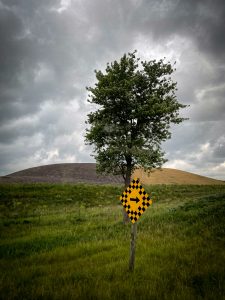
Looking at the photograph one sees four distinct elements. One sees a sky filled with dark ominous clouds over the top of a large hill; black on one side, light brown on the other. Green grass appears midway done the hill and flows downward in the frame to and around a tree, and caution sign. So what is the story here? What could this have to do with good and evil? The Oneida woman tour guide began by saying that this area is a landfill site, simply known as Greenlane, which borders on her community. On the other side of the bus, I saw a large fenced in compound with massive bulldozers, trucks and equipment busily moving refuse (garbage) around and into distinct buildings where it would be sorted. There were other structures and lots of security.
My attention went back to the other side of the bus and the four elements, sky, earth, tree and sign, which I couldn’t resist admiring in some strange way. The tour guide explained that the site has been a place of contention for well over a decade and a half. She explained that this is where the garbage from Toronto, Canada’s largest city, ends up (First Nation Drums, 2020). Given the unending stench, noxious gases, constant noise of the operation, and leakage of toxins and unsafe bio-matter into both the soil and, more grave, the ground water, it is safe to say this is where evil resides. Residents of Oneida Indian Nation, impacted by this environmental nightmare, are living with this evil and no amount of money can rectify this dark side of humanity.
As I continued to contemplate how could such good, represented here by nature – sky, Mother Earth, and tree, be so tainted by such evil, I realized quite quickly that this practice cannot be sustained. These hills of garbage, stretching for miles, bordering on this First Nation reserve, are reminders of rapid population growth, environmental degradation, and, more disturbing, environmental racism. No amount of grass seed can hide the environmental racism that seeps into the community. As if this scene needed a more sickening twist. The tour guide added, “yes, last week, they found a dead body in the garbage. It seemed to slow things down a bit; but, not for long. We don’t know when this will end. And, our people are getting very sick. Cancer and respiratory disease are sky-rocketing”.
My story ends on a realist note. It may be the creation story of the 21st century. Evil attacks the most vulnerable, the marginalized, and our First peoples. Evil spirits are definitely in existence. We simply need to see the signs such as foreboding storm clouds or the caution signs designed to help us avert danger. It’s up to each of us to see that the good spirits rise up to take care of the evil ones to ensure our survival as humans, the two-legged. I see signs that we are slowly beginning to realize that there is peril in not heeding the warning signs and our responsibility as citizens.
As we transition now into more of a historical examination, let us not forget we need to pivot constantly in time. This course will have you at times in the past, present and future. It is our way to honour our ancestors, live in the present with our obligations of today for the next seven generations, the future. I would like to present a writing that may not be well-known; but, may provide some further answers to the question, what is Canada? The writing is titled, Treaty Six Territory – June 21st, 2036.
Treaty Six Territory – June 21st, 2036
“Looking back on the past twenty years, I am ever-surprised at how far Canada has come. When I was a boy, growing up in a farming community in rural Saskatchewan, what I am doing now would have never happened. I am taking my two daughters to the local First Nations reserve – for the third day in a row – to attend the culture festival. Quickly becoming an annual tradition for everyone in the area, the culture festival is a week long event celebrating indigenous history and tradition in Canada. As a country-wide event, each reserve customizes it to reflect its own history and traditions. This has emerged as an extremely effective way to encourage us white folks – and other newcomers to Canada – to learn and grow not only in our own cultures and traditions, but to share in the rich traditions of Canada’s First Peoples. The fact that it builds and strengthens intercultural communities is a side benefit. Yesterday there was a powwow, the day before that we partook in a feast and smudge, and today we are gathered for a re-commitment ceremony of the treaty promises that were made so long ago.
Events such as these are not new to me. Growing up in the Saskatoon inner city and attending an elementary school where my siblings and I were the only white students, I was exposed to many Cree traditions and cultural values as a youngster. For that I am forever grateful. It is now my profound joy that these rich teachings can be shared not only with my own children, but with all of the families who live around us. To see the grown-up children from what had been the most racist families in the area bringing their little ones to an event like this warms my heart in a way words can not adequately describe. That now – instead of something that a select few white people would attend for solidarity’s sake – everyone in the community can gather together to smudge, feast, and dance.
I think that this is an almost magical shift from where things were at twenty years ago. When I look even further back into the past my awe only multiplies. For someone fifty years ago to imagine a future where farmers and people from the reserve could hold hands together and share in the beauty Canada has to offer would have been unheard of. There would, of course, have been people dreaming of a time like that, working for it, striving for it. But to imagine that an on-reserve culture festival would have become a mainstream tradition may have surpassed even their hopeful imaginations.
When I delve back even further into the past, into things that were already a subject of near legend during my childhood – despite their only recent eradication – I am blown away. To think that one hundred and fifty, even one hundred years ago, children were being forcibly removed from their families and traditions; thrust into an unfamiliar and hostile environment; stripped of their traditional clothing, teachings, and language; and abused, ‘educated’, and assimilated is unthinkable. Nowadays the residential schools and their legacy sound like a dystopian novel. This is Canada’s history.
If I were to tell you that the legacy of the residential schools has completely faded I would be a liar. And is Truth not the very basis of reconciliation? Without truth there can be no understanding, no reconciliation, no future. So, as I do not want to undermine how far we have come since Gordon Indian Residential school – a school run by my own church in my own province- closed its doors in 1996, I will not lie to you: the legacy of residential schools is still alive. Poverty, addiction, and a cultural disconnect are still present in Saskatchewan’s cities and reserves. The difference now is how it is dealt with. There are countless functional support systems in place to guide people – young and old – on their journeys through life. Prisons are no longer filled with poor people and disillusioned youth. In fact, today we are as close to a traditional First Nations society as we have been since first contact. The young people are cared for and mentored by the elders, and likewise, the youth provide for elders and people in need. Cultures and traditions are taught in all schools; to white and aboriginal people alike. Day by day racism, poverty, and injustice are being replaced with love, understanding, and reconciliation. Every morning is a fresh page in the tome of Canada’s history, and today’s authors are geniuses”. (Crowshire’s Blog, 2016).
This short story was written by Christopher Sanford Beck, 15 years of age from Saskatchewan, who entered the Imagine a Canada contest, sponsored by the National Centre for Truth and Reconciliation. He was one of 10 award recipients, who entered the contest which sought to have contestants “envision what the future of Canada will look like through the lens of reconciliation,” in either art, poetry, film or essay form (Office of the Treaty Commissioner, 2024). His winning piece embraces the very essence of what Canada is. Despite a dark past, this author believes that there can be a brighter, more rewarding and inclusive Canada.
I had the opportunity to meet some Imagine a Canada award winners from Prince Edward Island in 2017 (see Figure 7).
Figure 7: Imagine a Canada Visionaries and Artists (Charlottetown, PEI)

Behind our visionaries and artists we have Lennox Island First Nation Chief Matilda Ramjattan, Lieutenant Governor, Frank Lewis, Premier Wade McLaughlin, Abegweit First Nation Chief Brian Francis, and National Centre for Truth and Reconciliation Director Ry Moran. These individuals no longer occupy these positions; however, I do recall them as very dedicated individuals who advanced truth and reconciliation, and do so today. So we find leaders and youth engaged in identity seeking and making, an important aspect of ‘being’ before action is taken, through this process of reconciliation and nation-to-nation rebuilding.
So whether a youth, national or provincially elected official, or First Nation, Inuit or Métis leader, Canada has been trying to find its identity since its birth in 1867. This search also pre-dates Confederation, which we will examine later. We will examine more closely now the next topic in this session, what is Turtle Island?
What is Turtle Island?
There are a series of videos that best describe what is Turtle Island? However, there are two interesting pictorials we should . First, did you notice the IKERAS log? What is it? Let’s take a minute to review it together (see Figure 7).
Figure 8: IKERAS Faculty Logo
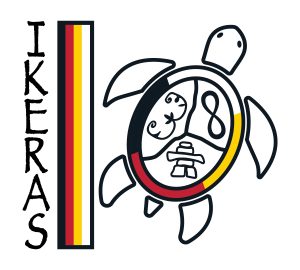
This logo was created by Dr. Corinne Chappell, Advisor to the Office of the Vice President, Academics and Research on Indigenous Initiatives. Recall that you were introduced to the sacred creature, the turtle, in the recounting of the Sky Woman Creation Story. Can you remember what was placed on the back of the turtle. What symbols are on the back of the IKERAS Faculty turtle? If you answered, the three nations that comprise Indigenous peoples in Canada – First Nations (represented by the double-curve Mi’kmaq symbol), Métis Nation (represented by the infinity circle), and Inuit Nation (represented by the Inukshuk), then you are correct. IKERAS honours the knowledges from each of these distinct nations, and we are so fortunate to have each nation represented in our Faculty. You may wish to conduct additional research around the symbols themselves as there is much deeper meaning and a history to how these were created as well. What do you know about the teachings of the sacred four colours also represented on the turtle and the banner beside IKERAS? We may leave this for now; but, it will definitely surface in our learning journey.
The other picture is one that is getting closer to the meaning of Turtle Island (see Figure 8).
Figure 9: The Legend of Turtle Island Map
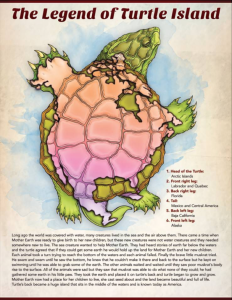
There are other maps that we will explore, and are part of a PowerPoint presentation entitled, Turtle Island Maps. According to UPEI Indigenous scholar, Dr. John Doran, Faculty of Education, he states, “Turtle Island is what we now call Canada, the US and Mexico, including all the Islands in what we now call the Caribbean.” Most of the literature respecting Turtle Island confirms this with the occasional variation. I’ve come across statements that only refer to North America. How far into Central America is also not totally defined. However, we know, and most important, that a significant portion of peoples live on Turtle Island, Indigenous and non-Indigenous.
According to Worldmeter, which tracks ‘live’ population data, there are over 1 billion people that live in North and Central America and the Caribbean. Of that number, according to several sources (Statistics Canada, United States Census Bureau, and The World Bank), they estimate that there are approximately 50 million peoples who self-identify as Indigenous in their jurisdiction. This equates to about 5% of the total population, the same percentage number as is worldwide and also in Canada. We will examine more fully Indigenous and non-Indigenous relations in these countries in later sessions. Recall the land and people acknowledgement that opened this textbook, can you remember one whose land the University of Prince Edward Island is situated? If you said, the land of the Mi’kmaq (L’nu) peoples, you are correct. We will now explore who are the Mi’kmaq peoples?
Who are the Mi’kmaq Peoples?
There are three prominent websites that one should visit to get a good sense of who are of the Mi’kmaq peoples of Epekwitk (Prince Edward Island), These include 1) L’nuey, the PEI Mi’kmaq Rights Initiative “that focuses on the advancement, implementation, and protection of the constitutionally entrenched rights of the Epekwitnewaq Mi’kmaq (Mi’kmaq of PEI). L’nuey means “belonging to the people” and it is the guiding principle behind the negotiations, consultation and governance development work that will happen through the organization.”; 2) Lennox Island Mi’Kmaq First Nation, one of the two main First Nation communities located in the north-west part of PEI; and 3) Abegweit First Nation, the other large Mi’kmaq community, which is located in central PEI. An exploration of these sites will highlight important facts and information about the Mi’kmaq peoples. There are close to 1,500 Mi’kmaq peoples that call Epekwitk their home. One of the best ways to get to know the Mi’kmaq are to visit their community when they have their annual Mawi’omi (gathering of the people), often referred to as a Powwow. I always try to make at least one of the communities’ event each year. Here is an example of what you may see at a Mawi’omi (see Figure 10).
Figure 10: Charlottetown Mawi’omi hosted by Mi’kmaq Confederacy of PEI

We (UPEI’s Mawi’omi Indigenous Student Centre and partners) have hosted numerous gatherings on the university’s campus in past years. One of my true pleasures are taking photographs at these events. I absolutely am in awe of the the cultural performers, the regalia, the atmosphere, all those who attend, and the opportunity to enjoy all that the Creator gives us including food for the body, mind and spirit (see Figure 11).
Figure 11: UPEI Cultural Connections Mawi’omi

It should be noted that, and this will add another layer of complexity with regards to Canada’s policies respecting Indigenous peoples, many Mi’kmaq peoples live off-reserve. Reserves (now most often referred to the First Nation community by name, e.g.: Lennox Island) were specifically designated lands where legally registered Indians (First Nation peoples) were placed to make room for the growing number of settlers that came to Canada. These reserves are not the only locations that the Mi’kmaq reside. In actual fact, the Mi’kmaq reside in just about every community on PEI. These Mi’kmaq peoples are referred to as living ‘off-reserve’.
One more complexity. There are close to 2,000 ‘off-reserve’ Indigenous peoples living on Prince Edward Island including the Mi’kmaq and countless other First Nation, Métis, and Inuit peoples. Many belong to the Native Council of Prince Edward Island, which “is a community of Indigenous people living off-reserve in traditional Mi’kmaq territory. NCPEI is the self-governing authority for all off-reserve Indigenous living on Epekwitk (PEI)“. They also have their own community powwow usually celebrated in August annual at Panmure Island (see Figure 12).
Figure 12: Young Cultural Perform at Panmure Island Powwow
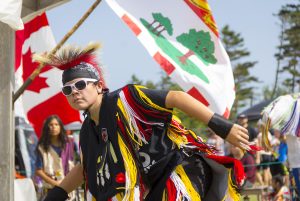
The Panmure Island Powwow is the last gathering of the year. To me it signals a time to enjoying the last bit of summer before school begins in September. I take time to express gratitude to the many individuals who work tirelessly and give their all to have such events happen. It’s truly a cultural celebration and a time to see and speak to friends who you may not have seen all year.
Moving beyond Epekwitk, one of seven districts that comprise Mi’kmak’i, we find additional communities of Mi’kmaq peoples. The map below in Figure 13 shows the seven districts, the Canadian provinces where these traditional lands and peoples are situated, and its proximity to the Province of Quebec, Canada, and the state of Maine, United States, which both have Mi’kmaq peoples within their present-day jurisdictions.
Figure 13: Map of The Mi’kmaq
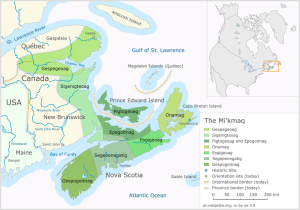
One of the more concise descriptions of the Mi’kmaq peoples and their lands is provided by The Confederacy of Mainland Mi’kmaq, in the 2007 publication titled, Kekina’muek: Learning about the Mi’kmaq of Nova Scotia. Figures 14 & 15 provide a very good overview of the Mi’kmaq peoples, past and in contemporary times.
Figure 14: Seven Districts and Traditional Territories of the Mi’kmaq
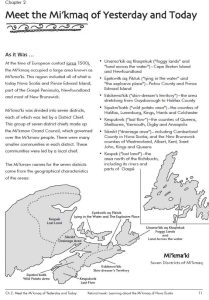
Figure 15: Contemporary Facts respecting the Mi’kmaq peoples
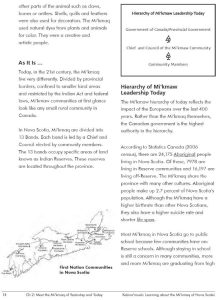
Another important source is Mi’kmawe’l Tan Teli-kina’muemk ~ Teaching About the Mi’kmaq (Eds. Tim Bernard, Leah Morine Rosenmeier, and Sharon L. Farrell), published in 2015 by the The Confederacy of Mainland Mi’kmaq, Truro, Nova Scotia. We will discuss the Mi’kmaq peoples further, and explore also the writings of Mi’kmaq historians Daniel N. Paul (Indian Brook Indian Reserve No. 14, Nova Scotia) and John Joe Sark (Lennox island First Nation, Prince Edward Island). Sadly, we lost both of these wonderful Elders, gifted Knowledge Keepers, in 2023. These Mi’kmaq historians spent a lifetime educating several generations about the lives of the Mi’kmaq peoples. They are truly missed. Given their contributions and in honour of their teachings, it would be a good time to discuss the last topic in the chapter, what are Indigenous teachings?
What are Indigenous Teachings?
There are two websites that offer a wealth of information regarding Indigenous teachings. However, before visiting them, it would be good to define what Indigenous teachings are. Do you recall the earlier discussion on Indigenous ways of knowing, being, and doing? What did this refer to? If you said, it’s a particular worldview that Indigenous peoples embrace to make sense of the world, and their enacted relationship with all living and non-living entities, you are most correct. We will spend time in the next chapter diving deeper into this concept. However, the connection to Indigenous teachings is significant. Remember that it is the learning process that becomes the method by which we gain knowledge. We learn from those who have a mastery of specific knowledges. I’ve mentioned a few times that these individuals are our Elders and Knowledge Keepers. One site to which I referred to earlier was the Four Directions Teachings website, which profiles the work of such Elders as Mi’kmaq Elder Stephen Augustine and Cree Elder Mary Lee. Four other cultural teachers are highlighted including Mohawk Elder Tom Porter, Ojibwe Elder Lillian Pitawanakwat, and Blackfoot Elders Dr. Reg Crowshoe and Geoff Crow Eagle.
Another website that I recently discovered is one created by the College of Alberta School Superintendents. In describing Indigenous teachings, the authors state,
“Indigenous teachings encompass ways of knowing, being, and doing that are actively practiced or learned. Teachings is the English word used to describe the process of sharing knowledge or original Indigenous methods of educating. Original practices and teachings are distinct to each diverse Indigenous group and continue despite centuries of legal and extralegal oppression and demonizing such as forced assimilation laws, policies, attitudes, beliefs and practices rooted in genocide that are inflicted on Indigenous Peoples. The more one understands Indigenous Peoples through our relationships with each other, language, and the land the more it is evident that Indigenous knowledge systems and methods of educating are rich and necessary. Lifelong learning is continual and includes many kinds of teachers that extend beyond the walls and halls of schools which includes learning from the land” (CASS, 2024).
As students who seek to expand their knowledges, professional skills, and competencies, Indigenous teachings can provide the ideal pathway of challenging the dominate culture worldview and mindset, which lacks an important feature – relational accountability. Cree researcher Shawn Wilson (2008) reminds us that “Indigenous epistemology (knowing) and ontology (being) is based upon relationships, and axiology (doing) is based on relational accountability”. It is relational accountability, the central theme in the teachings, that allows us to survive and thrive. I will discuss this more in the next chapter. For now, know that the Elders, Knowledge Keepers, and Indigenous scholars, those who teach Indigenous education (public K-12 schools and post-secondary institutions) through a pedagogy that is quite distinct, as it too is rooted in the teachings (see Figure 16).
Figure 16: Teachings from Elder. UPEI: IKE 2042: Indigenous Music, Film, and Art Class

Indigenous teachers, whether traditional or contemporary, present on any number of topics. For example, if one were to “google’ the term Indigenous teachings, here are just a few of the “hits” on Indigenous teachings:
- values
- humility
- about trees
- sacred ceremonies
- water
- for a sustainable future
- protocols
- medicine wheel
- health
So I will conclude this chapter by saying, you are now no doubt starting to see that the world of Indigenous peoples is unique. The next chapter will really highlight how distinct by examining their respective cultures. I highlight a number of important terms that will also be important in building your language and knowledge repertoire relating to Indigenous peoples.
Key Terms and Concepts from Chapter
- Canada: Different perspectives
- honouring our ancestors / seven generations
- Turtle Island
- Indigenous teachings / Indigenous worldview
- Elders, Knowledge keepers, and Indigenous scholars
- helpers / Elders-in-the-making
- relational accountability
- Indigenous peoples (First Nations, Métis, and Inuit)
- L’nu (Mi’kmaq) peoples
- On-reserve / off-reserve
- District of Epekwitk / Mi’kmak’i
- cultural performers / regalia
- truth and reconciliation
Important Readings / Viewings for Next Class
- Chapter 3: Indigenous Ways of Knowing (pp. 44-59) in Frideres, J. S. (2020). Indigenous peoples in the twenty-first century. Oxford University Press.
- Chapter 1: Just Don’t Call Us Late for Supper: Names for Indigenous Peoples (pp. 7-13) in Vowel, C. (2016). Indigenous writes: a guide to First Nations, Metis, & Inuit issues in Canada. Portage & Main Press.
Special Topics
Life in the Beginning – Elder Stephen Augustine (Start viewing at 12:30 to 30:00 minutes)
Cultural Competency Tutorials
How to talk about Indigenous people
References
Wagamese, R. (2016). Embers: One Ojibway’s Meditations. D & M Publishers.
